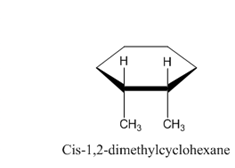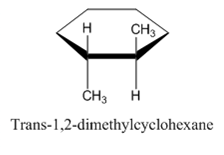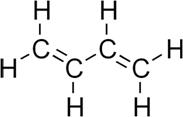
Concept explainers
(a)
Interpretation:
The given statement is true or false should be determined.
The IUPAC name of an alkene is derived from the name of the longest carbon chain that contains the carbon-carbon double bond.
Concept Introduction:
The IUPAC name is the set of rules that is created and applied by the International Union of pure and Applied Chemistry to generate systematic proper name of chemical compounds. This nomenclature is used to describe and identify the type and position of
Cis-trans stereoisomerisms are seen in alkenes compounds. Due to presence of two different groups bonded to carbon of carbon-carbon double bond, restricted action occurs in it and results into cis-trans isomerism. If same groups are present on the same side, then the isomer is called as cis-isomer and the same groups are present on different side the isomer is called as trans-isomer.
Answer to Problem 11P
The given statement is true.
Explanation of Solution
As per general rules of
(b)
Interpretation:
The given statement is true or false should be determined.
The IUPAC name of
Concept Introduction:
The IUPAC name is the set of rules that is created and applied by the International Union of pure and Applied Chemistry to generate systematic proper name of chemical compounds. This nomenclature is used to describe and identify the type and position of functional groups, side chains, double or triple bonds etc. in alphabetical order to provide systematic name to compound.
Alkenes are the compounds with very weak London dispersion forces and are nonpolar. They contain same skeleton structure and physical properties like alkanes but liquid at room temperature.
Cis-trans stereoisomerisms are seen in alkenes compounds. Due to presence of two different groups bonded to carbon of carbon-carbon double bond, restricted action occurs in it and results into cis-trans isomerism.
If same groups are present on the same side, then the isomer is called as cis- isomer and the same groups are present on different side the isomer is called as trans- isomer.
Answer to Problem 11P
The given statement is false.
Explanation of Solution
IUPAC name of
Therefore, the given statement is false.
(c)
Interpretation:
The given statement is true or false should be determined.
2-Methyl-2-butene shows cis-trans isomerism.
Concept Introduction:
The IUPAC name is the set of rules that is created and applied by the International Union of pure and Applied Chemistry to generate systematic proper name of chemical compounds. This nomenclature is used to describe and identify the type and position of functional groups, side chains, double or triple bonds etc. in alphabetical order to provide systematic name to compound.
Alkenes are the compounds with very weak London dispersion forces and are nonpolar. They contain same skeleton structure and physical properties like alkanes but liquid at room temperature.
Cis-trans stereoisomerisms are seen in alkenes compounds. Due to presence of two different groups bonded to carbon of carbon-carbon double bond, restricted action occurs in it and results into cis-trans isomerism.
If same groups are present on the same side, then the isomer is called as cis- isomer and the same groups are present on different side the isomer is called as trans- isomer.
Answer to Problem 11P
The given statement is false.
Explanation of Solution
2-Methyl-2-butene contains two methyl groups present on carbon atom of carbon-carbon double bond other carbon contains also methyl group.

To get cis and trans isomers, two different groups should be present on the carbon atoms of the carbons with double bond.
Thus, the statement is false.
(d)
Interpretation:
The given statement is true or false should be determined.
1,2-dimethylcyclohexene shows cis-trans isomerism.
Concept Introduction:
The IUPAC name is the set of rules that is created and applied by the International Union of pure and Applied Chemistry to generate systematic proper name of chemical compounds. This nomenclature is used to describe and identify the type and position of functional groups, side chains, double or triple bonds etc. in alphabetical order to provide systematic name to compound.
Alkenes are the compounds with very weak London dispersion forces and are nonpolar. They contain same skeleton structure and physical properties like alkanes but liquid at room temperature.
Cis-trans stereoisomerisms are seen in alkenes compounds. Due to presence of two different groups bonded to carbon of carbon-carbon double bond, restricted action occurs in it and results into cis-trans isomerism.
If same groups are present on the same side then the isomer is called as cis- isomer and the same groups are present on different side the isomer is called as trans- isomer.
Answer to Problem 11P
The given statement is false.
Explanation of Solution
Following are the structures of the isomers of 1,2-dimethylcyclohexane. Form this, we can see that all four atoms of carbon-carbon double bond are lying in same plane.


Therefore, the given statement is false.
(e)
Interpretation:
The given statement is true or false should be determined.
The IUPAC name of
Concept Introduction:
The IUPAC name is the set of rules that is created and applied by the International Union of pure and Applied Chemistry to generate systematic proper name of chemical compounds. This nomenclature is used to describe and identify the type and position of functional groups, side chains, double or triple bonds etc. in alphabetical order to provide systematic name to compound.
Alkenes are the compounds with very weak London dispersion forces and are nonpolar. They contain same skeleton structure and physical properties like alkanes but liquid at room temperature.
Cis-trans stereoisomerisms are seen in alkenes compounds. Due to presence of two different groups bonded to carbon of carbon-carbon double bond, restricted action occurs in it and results into cis-trans isomerism.
If same groups are present on the same side then the isomer is called as cis- isomer and the same groups are present on different side the isomer is called as trans- isomer.
Answer to Problem 11P
The given statement is true.
Explanation of Solution
The IUPAC name of
(f)
Interpretation:
The given statement is true or false should be determined.
1,3-Butadiene has two carbon-carbon double bonds and 22 =4 stereoisomers are possible for it.
Concept Introduction:
The IUPAC name is the set of rules that is created and applied by the International Union of pure and Applied Chemistry to generate systematic proper name of chemical compounds. This nomenclature is used to describe and identify the type and position of functional groups, side chains, double or triple bonds etc. in alphabetical order to provide systematic name to compound.
Alkenes are the compounds with very weak London dispersion forces and are nonpolar. They contain same skeleton structure and physical properties like alkanes but liquid at room temperature.
Cis-trans stereoisomerisms are seen in alkenes compounds. Due to presence of two different groups bonded to carbon of carbon-carbon double bond, restricted action occurs in it and results into cis-trans isomerism.
If same groups are present on the same side, then the isomer is called as cis- isomer and the same groups are present on different side the isomer is called as trans- isomer.
Answer to Problem 11P
The given statement is false.
Explanation of Solution
Following is the structure of 1,3-Butadiene. There are no stereocenters are present in the structure of 1,3-Butadiene. There should be presence of different groups for isomerism.

Therefore, the given statement is false.
Want to see more full solutions like this?
Chapter 12 Solutions
EP INTRO.TO GENERAL,ORGANIC...-OWL ACCE
- Fina x | Sign X Sign X lab: X Intro X Cop) X a chat x My x Grad xLaur x Laur x a sheg X S Shoj XS SHE X acmillanlearning.com/ihub/assessment/f188d950-dd73-11e0-9572-0800200c9a66/d591b3f2-d5f7-4983-843c-0d00c1c0340b/f2b47861-07c4-4d1b-a1ee-e7db27d6b4ee?actualCourseld=d591b3f2- 5 © Macmillan Learning Organic Chemistry Maxwell presented by Macmillan Learning For the dehydrohalogenation (E2) reaction shown, draw the Zaitsev product, showing the stereochemistry clearly. H H KOH Br EtOH Heat Select Draw Templates More Erase // C H Q Search hp Q2 Q Δ קו Resouarrow_forwardIs the structural form shown possible given the pKa constraints of the side chains?arrow_forwardon x Fina X Sign X Sign x lab X Intro X Cop X chat X My x Grac x Laur x Laur x ashes x S Shox S SHE x a eve.macmillanlearning.com/ihub/assessment/f188d950-dd73-11e0-9572-0800200c9a66/d591b3f2-d5f7-4983-843c-0d00c1c0340b/f2b47861-07c4-4d1b-a1ee-e7db27d6b4ee?actualCourseld=d591b3f2-c stions estion. ct each urces. +95 Macmillan Learning Draw the product formed by the reaction of potassium t-butoxide with (15,25)-1-bromo-2-methyl-1-phenylbutane (shown). Clearly show the stereochemistry of the product. H BH (CH3)3CO-K+ +100 H3CW (CH3)3COH +85 H3CH2C +95 ossible ↓ Q Search Select Draw Templates More C H 0 bp A Erase 2Q 112 Resouarrow_forward
- Identify the structure of the PTH derivative generated after two rounds of Edman degradation.arrow_forwardUse the data below from an electron impact mass spectrum of a pure compound to deduce its structure. Draw your structure in the drawing window. Data selected from the NIST WebBook, https://webbook.nist.gov/chemistry/ m/z Relative intensity 31 0.5 30 26 29 22 28 100 27 33 26 23 15 4 • You do not have to consider stereochemistry. You do not have to explicitly draw H atoms. • In cases where there is more than one answer, just draw one. 妊 n ? Previous Nextarrow_forwardfor this question. Write the molecular formula for a compound with the possible elements C, H, N and O that exhibits a molecular ion at M+ = 98.1106. Exact Masses of the Most Abundant Isotope of Selected Elements Isotope Natural abundance (%) Exact mass 1H 99.985 1.008 12C 98.90 12.000 14N 99.63 14.003 160 99.76 15.995 Molecular formula (In the order CHNO, with no subscripts)arrow_forward
- PLEASE READ!!! I DONT WANT EXAMPLES, I DONT WANT WORDS OR PARAGRAPHS!!! PLEASE I UNDERSTAND THE BASICS BUT THIS IS AN EXCEPTION THAT EVEN THE INTERNET CANT HELP!!!! THIS IS THE THIRD TIME I'VE SENT THOSE QUESTIONS SO PLEASE DONT RESEND THE SAME STUFF, ITS NOT HELPING ME!!! I ALSO ALREADY TRIED TO DRAW THE MECHANISM MYSELF, SO IF ITS RIGHT PLEASE TELL ME OR TELL ME WHAT I HAVE TO CHANGE!!! First image: I have to SHOW (DRAWING) the mechanism (with arows and structures of molecules) NOT WORDS PLEASE! of the reaction at the bottom. Also I have to show by mecanism why the reaction wouldn't work if the alcohol was primary Second image: I have to show the mechanism (IMAGE) (with arrows and structures of the molecules) NOT WORDS PLEASE !! for the reaction on the left, where the alcohol A is added fast in one portion HOMEWORK, NOT EXAM!! ALL DETAILS ARE IN THE IMAGES PLEASE LOOK AT THE IMAGES, DONT LOOK AT THE AI GENERATED TEXT!!!arrow_forwardWrite the molecular formula for a compound with the possible elements C, H, N and O that exhibits a molecular ion at M+ = 85.0899. Exact Masses of the Most Abundant Isotope of Selected Elements Isotope Natural abundance (%) Exact mass 1H 99.985 1.008 12C 98.90 12.000 14N 99.63 14.003 160 99.76 15.995 Molecular formula (In the order CHNO, with no subscripts)arrow_forwardUse the data below from an electron impact mass spectrum of a pure compound to deduce its structure. Draw your structure in the drawing window. Data selected from the NIST WebBook, https://webbook.nist.gov/chemistry/ m/z Relative intensity 59 3.0 58 64 43 100 15 23 • You do not have to consider stereochemistry. •You do not have to explicitly draw H atoms. • In cases where there is more than one answer, just draw one. + n[] 85 // ? CH4 Previous Nextarrow_forward
- Write the molecular formula for a compound with the possible elements C, H, N and O that exhibits a molecular ion at M* = 128.0632. Exact Masses of the Most Abundant Isotope of Selected Elements Isotope Natural abundance (%) Exact mass 1H 99.985 12C 98.90 14N 99.63 160 99.76 Molecular formula 1.008 12.000 14.003 15.995 (In the order CHNO, with no subscripts)arrow_forwardCan I please get help with this? And can I please the lowest possible significant number?arrow_forwardWhat is the molar mass of a gas that takes three times longer to effuse than helium?arrow_forward
 World of Chemistry, 3rd editionChemistryISBN:9781133109655Author:Steven S. Zumdahl, Susan L. Zumdahl, Donald J. DeCostePublisher:Brooks / Cole / Cengage Learning
World of Chemistry, 3rd editionChemistryISBN:9781133109655Author:Steven S. Zumdahl, Susan L. Zumdahl, Donald J. DeCostePublisher:Brooks / Cole / Cengage Learning Introduction to General, Organic and BiochemistryChemistryISBN:9781285869759Author:Frederick A. Bettelheim, William H. Brown, Mary K. Campbell, Shawn O. Farrell, Omar TorresPublisher:Cengage Learning
Introduction to General, Organic and BiochemistryChemistryISBN:9781285869759Author:Frederick A. Bettelheim, William H. Brown, Mary K. Campbell, Shawn O. Farrell, Omar TorresPublisher:Cengage Learning ChemistryChemistryISBN:9781305957404Author:Steven S. Zumdahl, Susan A. Zumdahl, Donald J. DeCostePublisher:Cengage Learning
ChemistryChemistryISBN:9781305957404Author:Steven S. Zumdahl, Susan A. Zumdahl, Donald J. DeCostePublisher:Cengage Learning Chemistry: An Atoms First ApproachChemistryISBN:9781305079243Author:Steven S. Zumdahl, Susan A. ZumdahlPublisher:Cengage Learning
Chemistry: An Atoms First ApproachChemistryISBN:9781305079243Author:Steven S. Zumdahl, Susan A. ZumdahlPublisher:Cengage Learning




